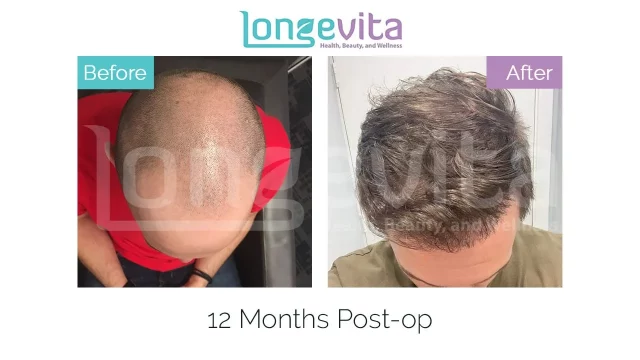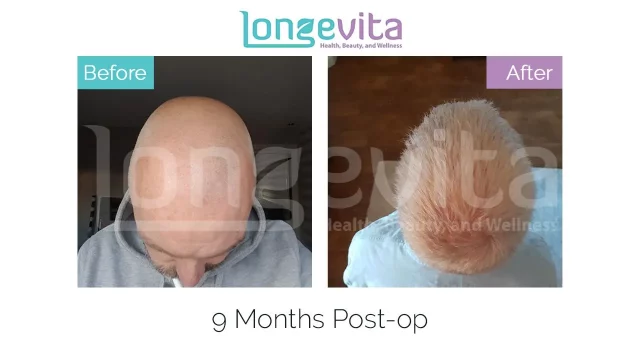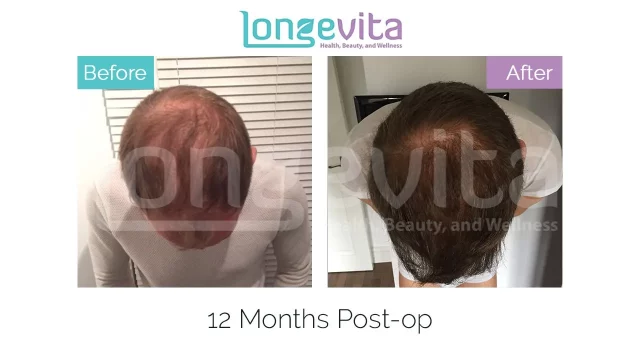What is a Body Hair to Head Transplant?
A body hair transplantation (BHT) can restore hair growth on the scalp by harvesting body hair. Many people wonder if their body hair can be transplanted onto their scalp. It can be taken from the beard, arms, legs, chest, abdomen, pubis, and/or underarms. However, body hair transplant has a significantly low success rate. Moreover, it might not yield permanent results.
There are two different types of hair on the body: vellus and terminal hair.
Vellus hair is thin, fine, and lightly pigmented. It is the hair you see on your face, legs, and arms.
These hairs have a very short anagen (growth) stage and a much longer telogen (resting) stage.
Vellus hair in some areas of the body can become terminal hair after puberty, like the underarms, pubis and beard.
Mainly, it is this terminal hair that is used for body hair to head transplants. However, surgeons also use vellus hair for BHT.
Reasons for Low Surgical Success Rate
The reason why this surgery has an overall low success rate is that it is difficult to ensure the survival of the grafts.
- Where the duration of the anagen (growth) phase of the scalp hair is between 2-10 years, the anagen phase is only about 4 months long in all areas of the body, except for the beard.
- At any given time, more than 50% of the body hair is in the telogen phase, whereas only 10-15% of the scalp hair is in this phase. When harvesting the hair grafts, the surgeon needs to extract those hair follicles that are in the anagen phase.
- The exit angle of body hair is more acute than the hair on the scalp.
- How deep the follicle extends into the dermal tissue varies in different areas.
- There’s a huge variation in the hair growth pattern in one area of the body, for instance, the whorls in the beard region.
- In the scalp, it is common for a follicular unit to contain more than 1 hair follicle. However, the follicular units in the body hair usually have 1-2. As a result, to achieve adequate coverage and density, more hair grafts are needed.
This all means that highly specialised tools and instruments are needed for different parts of the body to lower the transection rate, which still remains unusually high.
How much does a Body to Head Transplant Cost?
Body hair transplants in Turkey may cost upwards of £2,000 due to their complexity.
While it might still be cheaper than getting this surgery in the UK, keep in mind that its results are much less likely to be permanent.
In general, however, a scalp hair transplant in Turkey is far more affordable than in the UK or Europe. The reason for it is the lower surgical fees and exchange rates.
Moreover, there’s much less likely to be a price variation depending on how many grafts the patient needs for desired hair density.
Medical tourists also get accommodation, transportation, and comprehensive aftercare services.
Who Can Have Body Hair Transplant & Why
Body hair for hair transplant is recommended for those patients who have a depleted donor area and have extensive baldness due to:
- Pattern baldness
- Alopecia areata
- Physical trauma
- Scarring (cicatricial) alopecia
- Trichotillomania (hair-pulling disorder)
However, to be a candidate for a hair transplant from body hair, the patient needs to be hairy (hirsute).
That’s why more males can get their body hair transplanted on the scalp than females.
They also make good candidates because of their thick beard hair.
Since these are unwanted hairs, in most instances, patients do not have a problem using them for their balding scalps.
Torso Donor Index (TDI)
The author of the book FUE from the Beard and Body, Robert H True, has developed a torso donor index (TDI) to determine the suitability of a patient for a body-to-scalp hair transplant.
When the TDI Index is lower than 4, a patient cannot undergo this surgery. In this, 5 hair characteristics are evaluated:
- Density of follicular units
- Similarity in the hair texture of the body and scalp
- Number of follicular units containing 2-3 follicles
- Length of the hair
- Area of hair-bearing regions
What To Think About Before You Have Body Hair Transplant
With this kind of surgery, it is important that you ask your surgeon the following questions:
- What is their experience, licensing, and training?
- How many body hair-to-head transplants have they performed? Can you see the surgical portfolio?
- What is the success rate of the surgery?
- What kind of complications have patients experienced after their body hair extraction for scalp transplant?
- Can you meet a previous patient of the surgeon who had body hair for a hair transplant?
- What is the aftercare plan?

Preparing for Body Hair Transplant Surgery
To prepare for your FUT surgery, here are some common pre-operative do’s and don’ts:
Do...
- Inform us about your routine medications and any diseases. Don't forget to inform us of any changes to your health or medications
- Inform us at least 1 week prior to your arrival if you have any redness, rash, itchiness, pimples or dandruff on your head
- Stop taking Asprin, blood thinners, steroids or anti-inflammatory medications 1 week prior to your procedure
- Stop using Minoxidil or Finasteride for 1 week prior to surgery
- Wear a buttoned shirt or zipper top when coming to the clinic
- Remove any sprays, gels or cosmetics prior to coming to the clinic
- Take all your regular medications as normal, except for the ones we asked you to stop
- Stop taking blood thinners 2 weeks before the surgery
- If you are taking broad beta-blockers please contact your surgeon before your surgery
Don't...
- Don't smoke, drink alcohol or do any recreational drugs at least 1 week before the surgery.
- Don't take vitamin B and E for 1 week before your procedure
- Don't take any herbal products or vitamins for 1 week prior to surgery
- Don't cut your hair - leave it as long as possible as it makes planning for the procedure easier. If you are wearing a hair system, remove it 3 days prior to your procedure
- Don't wear a t-shirt or any clothing that must be pulled over your head
- Don't drive on the day of your treatment. You will be given a sedative and will not be fit to drive afterwards
- Don't take any supplements 1 week before your hair transplant
Please note: Cardiac patients may need written consent from their cardiologist.
What Is The Procedure For Body Hair Transplant?
Before performing the surgery, the surgeon determines the number of grafts the patient needs and in which regions of the scalp. The surgery may need custom instruments.
Surgical Instruments
With the help of a motorised punch tool – the punch ranging in size from 0.7-0.9mm – the surgeon extracts the hair roots from the body.
However, if the donor site is facial hair, the surgeon may use a hypodermic needle with different gauge (needle hole) sizes to extract the hair. That’s because the beard hair is thicker and coarser.
After the extraction, the surgeon uses a steel blade of different sizes to insert the body hairs into the scalp.
Since the hair quality and size are different in different areas of the body, unlike head hair, the size of incisions has to be different.
It’s a reason why it is not possible to transplant a large number of grafts in one session.
Donor Areas
- Crown/Vertex & Top: If the hair loss is occurring in the crown region or top of the scalp, surgeons prefer beard hair, pubic hair or hair from the armpits.
- Hairline: Patients suffering from hair loss along the hairline usually get grafts from the leg hair, chest hair, abdomen and arms. That’s because shorter, thinner hair looks more natural. This kind of donor hair is also suitable for eyebrow transplants and eyelash transplants.
Surgical Procedure
After the surgeon identifies donor areas on different parts of the body, they will use the FUE technique for:
- Extraction
- Implantation
First, the surgeon administers local anaesthesia in the part of the body from where the hair is going to be extracted.
The patient may need local anaesthesia in different areas of the body if there is more than one donor area. The punch tool/hypodermic needle extracts the grafts.
The surgeon stores them in a solution to ensure their survival. After that, incisions are made in the recipient area for implantation.
It may take around 10 hours to transplant 2,000 grafts. Usually, the surgery takes place in 1-2 days.
Depending on the aesthetic goals of the patient, the patient may need another surgery. However, it’s possible they may not have enough body hair grafts for it.
And if they do have enough hair, they have to wait for almost a year before getting another body hair-to-head transplant.

Recovery And Results
The patient will leave with bandages on the donor areas. You may need to wear them for 2-3 days.
It will be on the body and side/back of the head if combination grafting is done.
Take the medications that the surgeon prescribes for normal recovery.
Normal hair growth may start after 3-4 months. However, it may be 1-2 years before you see the final results.
Aftercare
A satisfactory outcome depends on realistic expectations from the surgery.
The patients should know that since body hair cannot grow as long as the hair on the head, they’ll always have short hair.
You can use scissors to style them after 2 months. However, you need to wait for at least 6 months before using a razor.
Initially, the hair may appear uneven due to the different quality of follicular units. However, do not rush in to dye your hair or wear a wig.
These things can cause permanent damage to the grafts, irritate the skin and increase the risk of infection.
Make sure that you avoid all activities that make you sweat. You may start scalp massages 2 weeks after the surgery to promote hair growth (consult your surgeon about this first).
Lastly, make sure to drink water and eat healthy foods for satisfactory results.
Alternatives to Body to Hair Transplants
If you do not have sufficient donor hair for hair transplant, you can get scalp micropigmentation (SMP).
It gives the illusion of hair follicles, and your scalp appears freshly shaven. If low hair density is the problem, SMP can fill in the balding regions.
Other Procedures to Have with Body Hair Transplants
The surgeon may recommend PRP injections after a body-to-scalp hair transplant. That’s because it may help increase the survival rate of the transplanted hair and promote healing.
Frequently asked questions about Body Hair Transplants
Unfortunately, body hair transplants do not yield permanent results.
The hair growth cycle of body hair is different from scalp hair, and they probably won’t adapt to the recipient site. You may lose all the new hair transplants after 2-3 years.
Only 0-10% of the hair grafts survive in body-to-scalp hair transplants.
Yes, because they are far more time-consuming and labour-intensive. Moreover, it requires customised medical equipment, which further raises the cost.
You may have these on different areas of the body, but they should fade with time.
If you’re experiencing any post-op complications, you can reach out to the aftercare team at [email protected].
You can also get in touch with your Patient Relations Specialist for advice from your surgeon.
In a body-to-head transplant, the surgeon will mix grafts from different areas of the body, all having different colours, textures, orientations and growth cycles.
There’s only the slightest possibility of the body hair taking the characteristics of scalp hair on transplantation.
This will result in an uneven appearance. And the results might not look natural, leaving the patient unsatisfied.
The hair grafts will not survive, so you’ll permanently lose the new hair transplants in the recipient areas after a couple of years.
If you do not follow the aftercare instructions, you may develop an infection in the donor and recipient areas.
Depending on the donor area, you may experience the following side effects:
- Temporary facial paralysis, which can cause droopiness
- Permanent nerve damage
- Keloid formation
- Hypopigmentation
- Ingrown hair
- Infection
- Telogen effluvium






